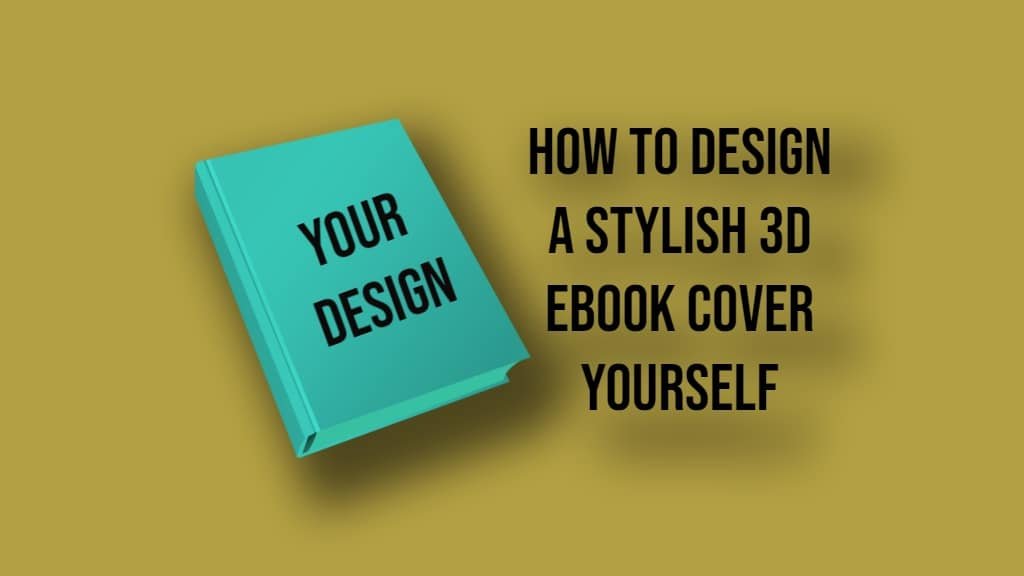A Comprehensive Guide to Creating Eye-Catching 3D eBook Covers
In the age of digital publishing, a well-designed eBook cover can make a world of difference in the success of your literary work. A captivating 3D eBook cover can pique readers’ interest, increase engagement, and boost your sales. As a self-published author, learning how to design your own stylish 3D eBook cover can save you money and give you control over your book’s presentation. This comprehensive guide will walk you through the process of designing a stunning 3D eBook cover that will make your work stand out from the competition.
Plan Your Design Concept
The first step in designing a 3D eBook cover is to come up with a concept that reflects the content and theme of your book. Consider the following:
- Genre: Research the typical cover designs for your genre to understand what readers expect and to ensure your cover stands out.
- Mood: Think about the emotions you want your cover to evoke. This will help guide your color choices, typography, and imagery.
- Target audience: Consider your ideal reader’s preferences and design a cover that will resonate with them.
Choose the Right Tools
There are several tools available for designing 3D eBook covers, ranging from free online tools to professional software. Some popular options include:
- Canva: A user-friendly online design tool with free and premium options. Canva offers an eBook cover design feature and 3D mockup generator.
- Adobe Photoshop: A powerful professional design software that allows for advanced editing and manipulation of images.
- Blender: An open-source 3D creation software that can be used to create custom 3D models and render 3D eBook covers.
Select Eye-Catching Typography
Your book title and author name should be legible and appealing. Consider the following when choosing typography:
- Font style: Select a font that matches your book’s genre and mood. For instance, a sleek sans-serif font may work well for a tech-related book, while a swirly script might be fitting for a romance novel.
- Font size: Make sure your title and author name are large enough to be easily read, even at a small thumbnail size.
- Color and effects: Use contrasting colors and effects (e.g., drop shadows, embossing) to make your text stand out against the background.
Design a Compelling Background
The background of your eBook cover should complement your typography and create visual interest. Some tips for designing a captivating background include:
- Use high-quality images: Choose high-resolution images that are free from artifacts and pixelation.
- Apply filters and adjustments: Modify the colors, contrast, and brightness of your background image to enhance its visual appeal.
- Incorporate 3D elements: Add 3D objects or textures to your background to create depth and make your cover more dynamic.
Create a 3D Effect for Your Cover
To transform your 2D cover design into a 3D eBook cover, you can either use a 3D mockup generator or create a custom 3D model. Here’s how:
- 3D mockup generator: Upload your 2D cover design to a tool like Canva or Smartmockups, and select a 3D template that matches your desired perspective.
- Custom 3D model: Use Blender or another 3D software to create a 3D model of your book cover. Apply your 2D cover design as a texture to the model, and render the scene with appropriate lighting and camera settings.
Review and Iterate
Before finalizing your eBook cover, take a step back and evaluate your design rom various perspectives. Ask yourself these questions:
- Does the cover accurately represent the content and tone of your book?
- Is the typography legible and visually appealing?
- Does the cover stand out among others in your genre?
- Is the 3D effect realistic and engaging?
If your design doesn’t meet all these criteria, don’t hesitate to iterate and make necessary changes. It’s also a good idea to get feedback from friends, family, or even your target audience, as they may provide valuable insights that can help you improve your design.
Export and Optimize for Different Platforms
Once you’re satisfied with your 3D eBook cover design, it’s time to export it in the appropriate formats and sizes for various platforms, such as Amazon Kindle, Apple Books, or Kobo. Each platform may have specific requirements, so ensure you adhere to their guidelines.
Consider exporting your cover in different formats, such as:
- High-resolution JPEG or PNG for your primary cover image
- Smaller, compressed versions for thumbnail display on websites or social media
- A PDF or vector file if you plan to print physical copies of your book
Test and Refine
After exporting your 3D eBook cover, upload it to the appropriate platforms and review how it looks on different devices, such as desktop computers, tablets, and smartphones. Make sure the cover remains legible, visually appealing, and accurately represents your book when displayed on various screens. If necessary, make any final tweaks and re-export your cover until it’s perfect.
Conclusion
Designing a stylish 3D eBook cover yourself may seem daunting at first, but with careful planning, the right tools, and attention to detail, you can create a captivating cover that will grab your readers’ attention and boost your book’s visibility. By following these steps and continuously refining your design, you’ll be well on your way to creating a stunning 3D eBook cover that showcases your literary work in the best possible light.
A Curated List of Online Resources to Create Eye-Catching 3D eBook Covers
A well-designed 3D eBook cover can significantly impact your book’s success by attracting readers and boosting sales. As a self-published author or a budget-conscious designer, you may not have the funds to hire a professional designer or purchase premium software. Luckily, there are numerous free online tools available to help you design a stylish 3D eBook cover yourself. In this article, we’ll explore the best free tools that will enable you to create eye-catching 3D eBook covers without breaking the bank.
Canva
Canva is an easy-to-use, web-based design platform that offers a wide range of free templates, images, and design elements. With Canva, you can quickly create a 2D eBook cover using their drag-and-drop interface and then transform it into a 3D mockup using the 3D Book Mockup Generator.
Key Features:
- User-friendly interface
- Extensive library of free templates and images
- 3D Book Mockup Generator
- Customizable design elements
Adobe Spark
Adobe Spark is another free online design tool that allows you to create stunning eBook covers with its simple yet powerful interface. While Adobe Spark doesn’t have a built-in 3D mockup generator, you can export your 2D cover design and use a separate 3D mockup tool to create the 3D effect.
Key Features:
- Intuitive design interface
- A wide variety of templates and design elements
- Integration with Adobe Creative Cloud
- High-quality export options
DIY Book Covers
DIY Book Covers is a free online resource specifically designed for creating eBook covers. It offers an extensive library of pre-made templates and a 3D cover creator tool to transform your 2D design into a realistic 3D cover.
Key Features:
- Easy-to-use interface
- eBook cover-specific templates
- 3D cover creator tool
- High-quality export options
GIMP
GIMP (GNU Image Manipulation Program) is a free, open-source alternative to Adobe Photoshop. Although it has a steeper learning curve compared to Canva or Adobe Spark, GIMP offers advanced editing capabilities that can help you create professional-looking eBook covers. To create a 3D cover, you can either design a 3D model using a separate tool or apply perspective transformations and shading directly in GIMP.
Key Features:
- Advanced image editing capabilities
- Customizable interface and tools
- Extensive plugin support
- Active community for tutorials and support
Blender + GIMP/Canva
Blender is an open-source 3D creation software that, when combined with a 2D design tool like GIMP or Canva, can help you create fully customized 3D eBook covers. You can use Blender to model your 3D book cover, apply your 2D design as a texture, and render the scene with realistic lighting and camera settings.
Key Features:
- Comprehensive 3D modeling, sculpting, and rendering capabilities
- Ability to create custom 3D eBook cover models
- Integration with 2D design tools
- Active community and tutorials
Boxshot
Boxshot is a free online tool that enables you to create 3D mockups of your eBook cover using a variety of customizable templates.
Key Features:
- Wide selection of 3D eBook cover templates
- Simple controls for adjusting cover size, lighting, and camera angles
- High-quality rendering
- Export options for different image formats and sizes
Tinkercad
Tinkercad is a free, web-based 3D design tool aimed at beginners, making it easy to create simple 3D objects for use on eBook covers.
Key Features:
- Intuitive interface with drag-and-drop functionality
- Basic 3D modeling tools for creating custom shapes and objects
- Online platform with no software installation required
- Export models in various file formats for use in other 3D software or rendering tools
Google Slides
Though primarily a presentation tool, Google Slides can be a handy option for creating simple 2D eBook cover designs, which can then be used in other tools to create 3D mockups.
Key Features:
- Free, web-based platform
- Access to a variety of fonts, shapes, and images
- Collaboration features for real-time editing with multiple users
- Integration with Google Drive for easy file storage and sharing
Conclusion
Designing a stylish 3D eBook cover has never been more accessible, thanks to these free online tools. Whether you’re a novice or experienced designer, these resources offer a range of features and capabilities to create professional-looking 3D eBook covers that will grab readers’ attention and boost your book’s visibility. By leveraging these tools and experimenting with different techniques, you can create a standout cover that showcases your work in the best possible light.



